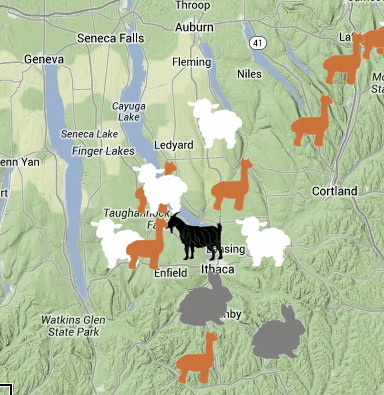I’ve been creating a map of fiber farms throughout New York to contribute to discourses about regional Fibersheds.

I inserted all of the addresses and identified the specific fiber animals that are one the farms. The map shows that there are extensive Alpaca farms, much more than sheep farms. This is because I was able to find a directory listing of several alpaca farms on the Alpaca Owners and Breeders Association. To find fiber farms with sheep, goat, and rabbits , I searched Ravelry, Fiber Festival websites, Local Harvest, Yarn Places Facebook, and received recommendations for collegues.
There are 145 different farms on this map. Most are in rural areas on Routes along the highway. The map below conveys the distribution based on general region.

There are several farms throughout the periphery of New York. The largest density is in Eastern New York, near Vermont and Massachusetts borders with 22 farms near Troy. This area is Washington County and hosts a fiber tour every year. People are invited to visit fiber farms and see fiber art demonstrations on the last weekend of April. Farms vary in the fiber animals they have, which distinguishes each farm in the region.
Below is a photograph of alpacas from the AREA Cria-tions Alpaca Farm that participates in the tour.


There are a diversity of fiber farms throughout New York that include sheep, alpaca, goats, angora rabbits, and llamas. The map below conveys the fiber farms that neighbor the Fingerlakes.

As integral contributors to New York’s agricultural landscape, these fiber animals are a part of the state’s regional and cultural heritage (although the amount is not as large as dairy farms). The diversity of fiber farms allows for extensive exploration and appreciation of these fiber animals and their regenerative fiber resources. The availability of these farms reflects the growing interest in fiber arts as spinners, weavers, knitters, and tourists take part in fiber tours. These farms can spur greater creativity among fiber artists, professional designers, farmers, and the general public. These farms are reachable, not significantly removed from landscapes we navigate through. The distance from Ithaca to New York is roughly 6-8 hours depending on mode of transit. The farms along the fingerlakes are a relatively short distance away from Ithaca.
Effort to get explore these farms is vital to encourage future proliferation of fiber farms as valuable contributors to the landscape. As one farmer explained, these fiber animals not only give us their fibers to use, they also act as “lawn mowing pets” that happily graze and fertilize the landscape in cycles. These fiber animals can become our partners in larger sustainable farming efforts.

What a great resource!
Thanks! It was fun making it 🙂
That always helps, doesn’t it?
I’d like to nominate you for the WordPress Family Blog Award… I enjoy reading your blog and your unfolding green textile path…
Thank you I’m honored. I’m happy that you enjoy reading it! 🙂 I love to share the work that I am doing, and appreciate any comments/ feedback.